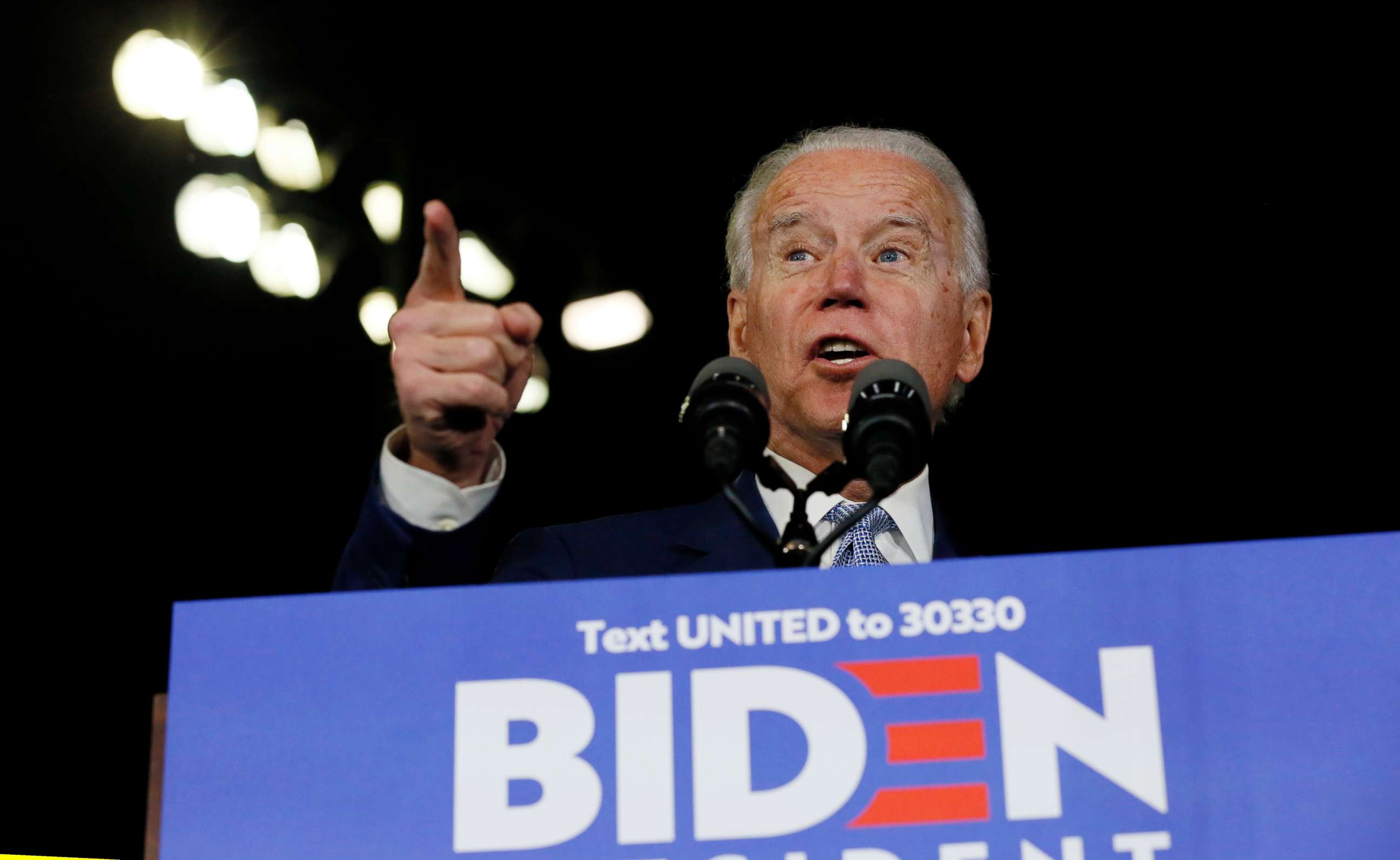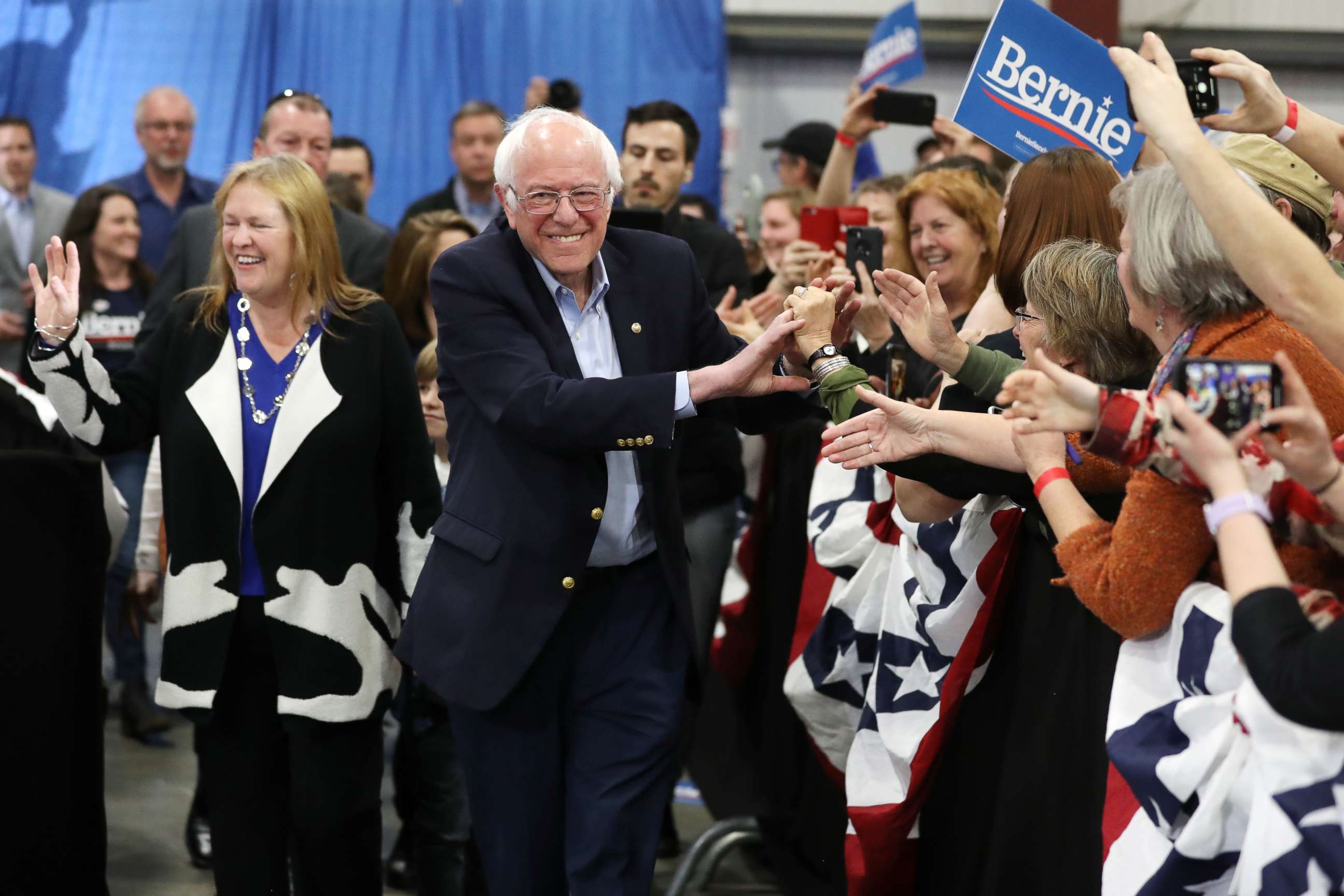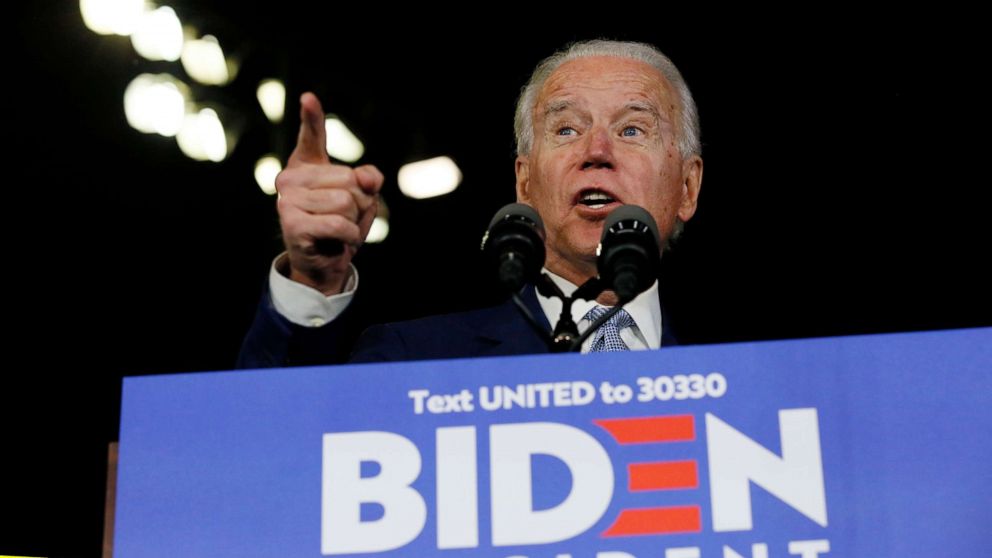Late support lifts Biden; Sanders keeps his base: Takeaways from Super Tuesday exit polls
A surge of late support lifted former Vice President Joe Biden on Super Tuesday, extending his candidacy beyond his southern strongholds as moderates coalesced behind his electability argument. Yet Sen. Bernie Sanders held broad support among issue voters, independents, Hispanics and the young, defining the battleground ahead.
Across the 12 states in which exit polls were conducted, Biden won 47% of Democratic primary voters who made their choice in the last few days – close to double his level of support, 26%, among those who decided earlier.
That marked the dramatic impact of Biden’s strong win Saturday in South Carolina and its aftermath – the departure of rivals former South Bend, Indiana, Mayor Pete Buttigieg and Sen. Amy Klobuchar and their endorsement of Biden, as well as a surge of endorsements from other Democratic leaders.
Biden’s surprise win in Minnesota was telling: He beat Bernie Sanders there by 53-19% among late-deciding voters. Lest there be no doubt, the 76% who viewed Klobuchar favorably backed Biden by a similar margin, more than 2-1.
Biden won his expected broad support among black voters, peaking at more than 70% in Alabama and Virginia. He did poorly, also as expected, among Hispanic voters, losing them to Sanders by 47-22% overall, largely owing to their comparative youth.
Less expected was Biden’s performance among whites, a group in which he beat Sanders in seven states (including by 15 percentage points in Minnesota and 8 in Massachusetts) and ran competitively in others (Texas and Maine). Even with the weight of California, Biden ran essentially evenly with Sanders among whites across the country, 30-28%. (Not counting California, it was 35-27%).

Biden’s electability argument, badly deflated after Iowa, New Hampshire and Nevada, was further revived. Sixty-two percent of voters in aggregate were focused more on the candidate who can beat Trump than on the one closest to them on the issues – and these electability voters went for Biden over Sanders by 12 points.
Sanders, for his part, won voters who cared more about issue alignment by an even wider margin, 18 points – but there were barely more than half as many of them.
At the same time, Sanders was formidable in his core groups. He won voters younger than 30 by a smashing 58-13% over Biden and those age 30 to 44 by 44-20%. “Very” liberal voters backed him by 47-18%, independents by 38-24%. On one of his signature issues, he won voters who support a government-run, single-payer health care system – 56% of all those who voted – by 43-22% over Biden.
Biden came back with moderates – three in 10 voters overall – by a wide 45-19%, and managed essentially an even split with Sanders among those who called themselves “somewhat” liberal.
The results were a letdown for candidates not named Biden or Sanders. Former New York City Mayor Mike Bloomberg had less of a popularity deficit than in South Carolina, where 66% saw him unfavorably, but still was rated more unfavorably than favorably in the three states where the question was asked, California, Virginia and Colorado. In Texas, North Carolina and Tennessee, additionally, 51% called it unfair for candidates to spend unlimited amounts of their own money on their campaigns.
With a Biden-Sanders duke fest on tap from here, a question for the party is whether or not its voters will line up behind the eventual nominee. Most on Super Tuesday, 82%, said they would do so. That included similar numbers of Sanders’ supporters, 83%, and Biden’s, 87%.
Alabama
Broad support among blacks, mainline Democrats, seniors and those seeking a return to former President Barack Obama’s policies lifted Biden in Alabama’s Democratic primary. Black voters made up 46% of the electorate – trailing only South Carolina in turnout among blacks in states with exit polls this year. They overwhelmingly picked Biden, to the tune of 72% – surpassing his 61% share Saturday.
Biden did similarly well among mainline Democrats, with 67% of their votes. He also won 76% of seniors (a third of Democratic primary voters in Alabama) and three-quarters of the majority who wanted to see a return to the policies of the Obama administration.
Health care, as in many other states, was a top issue in Alabama, at 49%, with income inequality, race relations and climate change each behind by 30 points or more. Biden led among voters focused on health care by a wide margin over Sanders, 59-14%. Biden even topped Sanders by nearly 2-1 among those who support a single government health plan, a signature Sanders issue.

Liberals were 53% of voters in Alabama; a strong group for Sanders in some other contests, but here they opted for Biden, 54-24%. That was consistent with Sanders’ poor performance in 2016 among liberals in the state.
California
A wide liberal base and perceptions of electability lifted Sanders in California. Two-thirds of California voters were liberals, and Sanders won them handily with 44%. (Warren won 20%, followed by Biden with 17%.) California voters also were most apt to see Sanders as best able to beat Trump in November – 35% said so, with Biden at 28%.
That was a reversal of positions for Sanders and Biden compared with aggregate results in the other states for which we have this exit poll question (all but Alabama). This especially helped Sanders because, as elsewhere, more than six in 10 were most focused on a candidate who can beat Trump, while a third cared more about supporting one who agreed with them on major issues.
Hispanic voters played a major role. Hispanics accounted for 28% of California voters, second only to Texas in contests so far this season, and gave an overwhelming 55% of their votes to Sanders – above even his 50% in Nevada, as well as his 45% in Texas. One reason for Sanders’ support among Hispanics is their comparative youth, given his strength with younger voters. Fifty-three percent of California Hispanic voters were younger than 45, compared with 35% of non-Hispanics.
Sanders may have been helped, as well, by the absence of later deciders in California, with its large share of early voters. Just 19% said they made their final decision in the last few days, least of any state.
At the same time Biden won seniors, 32-16% over Sanders, with 15% for Bloomberg, and the race was close among 45 to 64-year-olds. Biden also won moderates, 31-23% over Sanders, with an additional 24% for Bloomberg.
Colorado
In Colorado, Sanders was propelled by high levels of support among younger, liberal and issue-focused voters – especially those who supported replacing private health insurance with a single government plan and those who said the economic system needs a complete overhaul. As a mail-in voting state, Sanders didn’t have to contend here with the movement of late deciders to Biden.
Thirty-two percent of voters were under 45 years old, and Sanders won half of them. Sanders also did well among the two-thirds who were liberals, with 38% support, followed by Warren with 20%. (Biden and Bloomberg split moderates, 23-22%, with Sanders at 17%.) And Sanders fared well among mainline Democrats – a core Biden group – running ahead of the former vice president, 29-20%.

More voters in Colorado cited health care as their top issue – 36% – among four issues listed, and Sanders had 31% support among them, with Biden, Bloomberg and Warren each trailing by double digits. Voters divided between saying the U.S. economic system needs a complete overhaul (49%) or only minor changes (43%). Sanders led among both groups, though by a much wider margin among those favoring overhaul.
Maine
Favorable views of socialism, support for a single-payer health care system and desire for change lifted Sanders, while electability-focused voters and those looking for a unifying candidate boosted Biden.
Of four qualities tested, Mainers were most apt to prioritize someone who can bring needed change (41%) over someone who can unite the country (33%). Sanders won those desiring change by a 3-1 margin, while Biden won those who want a uniter by 6-1.
Democratic voters were particularly apt to see socialism favorably. Sixty percent said so, more than in any of the five states where the question was asked, with this group breaking for Sanders by 27 points. Biden won handily among those with an unfavorable opinion, by 48 points over Sanders.
Voters also expressed broad support for a single-payer health care plan, 69% – second highest after Vermont – and Sanders won this group by a wide margin.
Biden’s came back with electability. Thirty-nine percent saw him as the candidate with the best chance to defeat Trump, compared with 30% for Sanders. And among the 66% of voters who preferred a candidate who can beat Trump rather than someone who agrees with them on the issues, 42% went for Biden, 25% for Sanders.
Thirty-two percent of Maine voters are independents, a bit more than the average in all other Democratic primary exit polls today (26%), and 40% back Sanders. In terms of ideology, 27% are moderates – they go for Biden, with 49% support.
Massachusetts
Strong backing by moderates, seniors and late-deciding voters lifted Biden to victory in Massachusetts, followed by Sanders (backed by those younger than 45), then Warren, third in her home state. The three split voters in the progressive lane, with liberals dividing 33-28-27%, Sanders-Warren-Biden.
Timing played a considerable role in Biden’s victory. Fifty-one percent of Massachusetts voters made their decision in the last few days, second only to Minnesota in states with exit polls today. They voted for Biden, 43%; Warren, 20%; and then Sanders, 18%. Biden also won a substantial 47% of voters 65 and older.
Minnesota
Klobuchar’s exit from the contest Monday and subsequent endorsement of Biden paved the way for late-deciding voters to break heavily for the former vice president. Fifty-five percent decided their vote the last few days – the most of any state with exit polls tonight – breaking for Biden, 53%, vs. 19% for Sanders and 16% for Warren. Klobuchar’s popularity helped her endorsement carry water; 76% of voters expressed a favorable opinion of her, with 48% of them supporting Biden vs. 21% for Sanders.
Views of electability also boosted Biden. Sixty-five percent of Minnesota voters preferred a candidate who can beat Trump over one who agrees with them on the major issues. Biden won nearly half (47%) of electability-focused voters, compared with 21% for Sanders and 17% for Warren. In a related question, 45% pegged Biden as the candidate best able to defeat Trump, 18 points over Sanders.
North Carolina
A desire to return to the policies of Barack Obama and broad support from black voters boosted Biden in North Carolina, while under 45s and “very” liberal voters backed Sanders. Bloomberg faced voter concerns about vast campaign spending from candidates’ personal coffers.
Blacks made up 27% of voters, and like their counterparts to the south, they went strongly for Biden. It was a tighter contest among whites, who divided 31-25% between Biden and Sanders.
Fifty-six percent said they preferred to have the next president return to Obama’s policies, higher than in any other state except Alabama. That group went for Biden by 55-17% Biden-Sanders.
Fifty-four percent of voters called it unfair for candidates to spend unlimited amounts of their own money on their campaigns, vs. 42% who call this fair. Bloomberg did 14 points better among those who called it fair.
Oklahoma
Biden was buoyed by broad support among moderates, seniors, mainline Democrats and those looking for a return to Barack Obama’s policies. Biden won 46% of moderates – 22 points over Bloomberg and 33 points over Sanders.
Oklahoma had fewer liberals than any state to vote so far, a Sanders group. Biden also benefited from high turnout among seniors – they accounted for 35% of voters, among the most, and went for Biden with 48% support, with Bloomberg closest at 25%.
Biden won big among mainline Democrats, nearly two-thirds of voters, 45-21% over Sanders. And ties to Obama boosted Biden: Fifty-seven percent of voters who said they’d prefer a return to Obama’s policies voted for Biden, with Sanders at a distant 16%. While as many voters preferred a change to more liberal policies, Sanders won them by a narrower 21-point margin.
Tennessee
As in other southern states, Biden was bolstered by blacks in Tennessee as well as a focus on electability. Forty-one percent of voters said Biden stood the best chance of defeating Trump in November, compared with 23% who said the same of Sanders. And it was a key concern; 60% preferred a candidate who could beat Trump over one who agreed with them on major issues.
About a quarter of voters were blacks; 53% of them chose Biden.
Biden also ran ahead of Sanders with the 48% who desired a return to Obama’s policies. By contrast, Sanders led by more than 4-1 among the third of Tennessee voters who favored a more liberal turn. While Sanders prevailed over Biden by a narrow margin among independent voters (32-28), he was in a dead heat with Biden among liberals, each with 32%.
Texas
Texas voters divided 35-31, Biden-Sanders, over which candidate was best poised to beat Trump, a sign of the closeness of the race in the state.
Hispanics accounted for 31% of the electorate, the largest share of Hispanics in any state, and Sanders won 45% of this group. Blacks accounted for an additional 21%, and Biden won this group with 60% support. Voters also were sharply divided over which candidate best understands the concerns of racial and ethnic minorities, 33-32%, Biden-Sanders, with a majority of blacks (60%) choosing Biden and 43% of Hispanics picking Sanders.
A record number of “very” liberal voters turned out – 24%, up from 20% in 2016 – and Sanders overwhelmingly won this group, with 52% support. But a majority of moderates – also 24% of the electorate – backed Biden, 53%. Sanders benefited from broad support among younger voters, winning 65% among those under 30 and 48% of those 30-44. Still, as in other states, Biden drew broad support among older voters.
Biden also may have benefited from late-breaking endorsements. Twenty-two percent say they made their vote choice in the last few days, up from 15% in 2016. These recent deciders broke 49% for Biden, following endorsements in the state by Klobuchar, Buttigieg and former Texas Rep. Beto O’Rourke. Sanders led with 36% support among those who decided earlier.
Vermont
Sanders’ support in his home state was deep and broad. He dominated among his core groups, earning 68% of those 18-29 and “very” liberals alike, as well as nearly six in 10 independents. But Sanders also edged over Biden 39-28% among moderates and conservatives in the state. In a further demonstration of his home-state advantage, 46% of Vermont voters saw Sanders as the candidate best able to defeat Trump, the most in states with exit polls Tuesday.
Vermont stood in its support for a government-run single-payer health care system, backed by a broad 73%. About six in 10 in this group voted for Sanders, crowding out support for Warren, the other remaining candidate who’d campaigned for a single-payer system. (Warren and Biden won just 14% in this group alike.) On the flip side, Biden won 42% of voters who oppose a single-payer system.
Virginia
Many of the same factors that buoyed Biden in South Carolina also catapulted him to success in Virginia, including personal popularity, a focus on electability and his strength among the black electorate. More Virginia Democratic primary voters had favorable views of Biden – 73% – than any other candidate in the race (Warren had 51% favorability, Sanders 47%). Further, 57% saw Biden as the candidate best suited to beat Trump in November.
Biden also benefited from a strong showing among the 49% who made their voting decision in the last few days, following late endorsements by former Gov. Terry McAuliffe and U.S. Sen. Tim Kaine.
Sanders garnered broad support among the state’s youngest voters, winning 57% of the under-30 vote. He was also successful among voters who want to see the country take a more liberal turn rather than resume Obama administration policies – but they accounted for fewer than three in 10 voters in the state.
Analysis by Gary Langer, with Christine Filer, Sofi Sinozich, Allison De Jong, Laura Silver and Patrick Moynihan.




